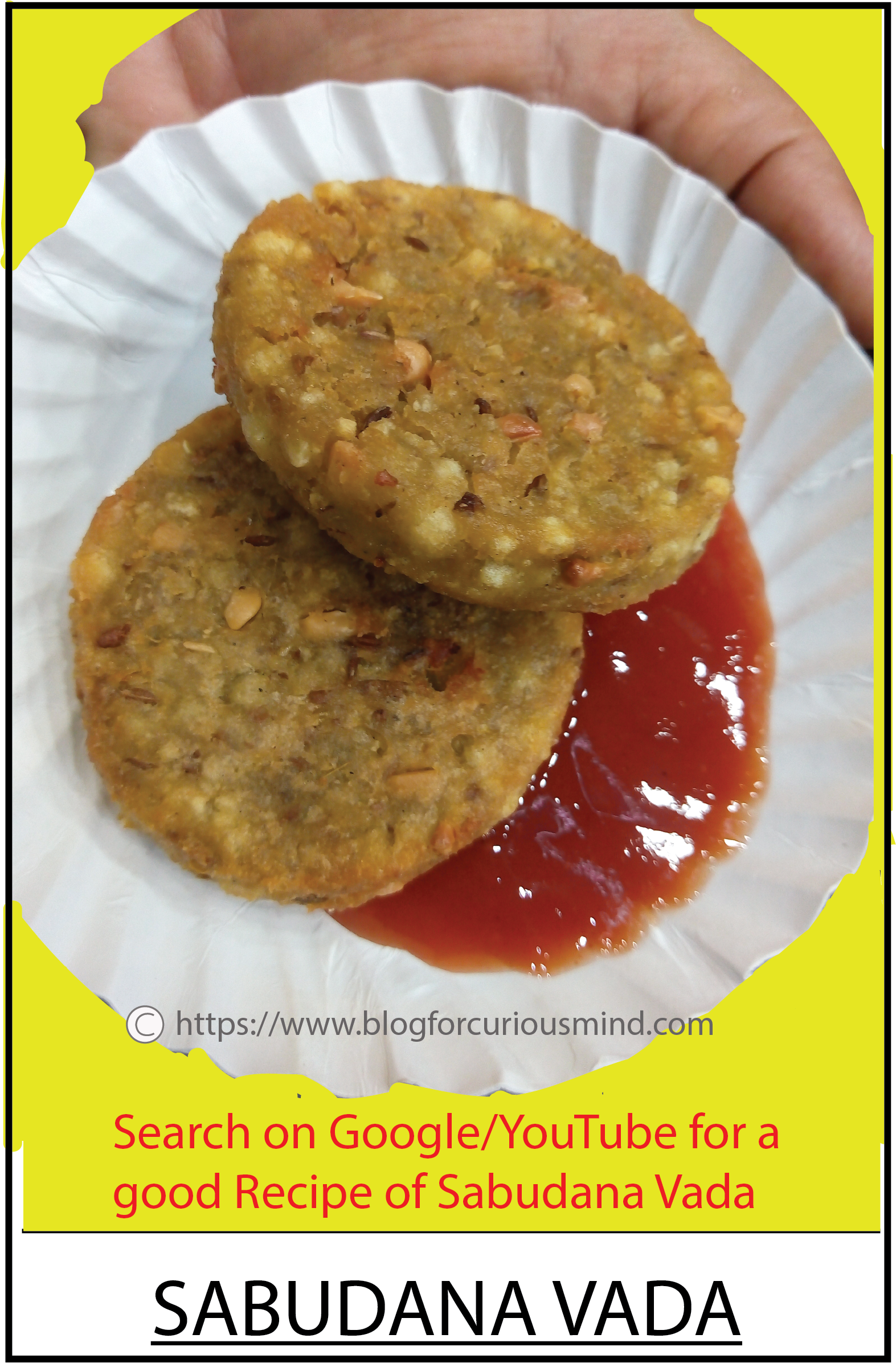Introduction
Most of you must have eaten the tasty dishes made from the white tapioca pearls called Sabudana. Yes, it immediately brings Sabudana kichadi, Sabudana Vada, and other delicacies into your mind. But, do you know Sabudana is not naturally grown like wheat or jowar, but it is manufactured?
The white pearls of Sabudana are made using the starch extracted from tapioca roots or sago stems and they are popular in many parts of the world. The Sabudana pearls available in India are normally made from tapioca starch.
Continue reading this article to learn more about Sabudana.
This article takes you through different subtopics.
- What is Sabudana made of
- What are tapioca pearls and sago pearls, are they the same or different
- Process of making Sabudana in India
- What is nylon Sabudana
- Brief history of Sabudana in India
- Popular Sabudana dishes prepared in India
- Food items prepared using tapioca pearls in other parts of the world
- Health benefits of Sabudana
- Advantages and disadvantages of Sabudana.
What is Sabudana made of?
In India, Sabudana is produced using the starch extracted from cassava root better known as tapioca root. The cassava roots are thoroughly cleaned and crushed and the milk obtained is processed to make Sabudana.
The cassava plant is said to be the native species of Central South America and North/North East Brazil. It later spread into many parts of the world including South America, Portugal, Spain, Southeast Asian Countries, and India.
Apart from Tapioca, starch can be extracted from potatoes, corn, sago stem/tree, palm trees, and wheat. China and Thailand are well known for making many products from starch. Sabudana pearls can be made from the starch obtained from a sago stem/tree and they are called sago pearls.
What are tapioca pearls and sago pearls, are they the same or different?
The white pearls, whether it is tapioca or sago, are called Sabudana in India. Of course, tapioca pearls are more popular in Indian homes and are highly sold in the market. Tapioca and sago are pure starches and do not have their own taste or odor. This makes them suitable for any dish, sweet or spicy.
Tapioca pearls are made from the starch obtained from the roots of tapioca or cassava (scientific name Manihot esculenta). You should soak the tapioca pearls in water for 4 to 6 hours before cooking it.
Sago pearls have the same look and use as the tapioca pearls. However, there are differences between sago pearls and tapioca pearls.
- Sago pearls are manufactured using the starch obtained from the pith of the sago tree/stem (scientific name Metroxylon Sagu).
- Sago pearls need less soaking time (2.5 to 3 hours) before it is ready to cook.
- Sago pearls are costlier than tapioca pearls and the reason can be it is sourced from outside India.
Process of making Sabudana in India
Sabudana pearls are made from cassava root, also known as tapioca. The process of making it from cassava root is explained below. In a Sabudana-producing plant, the material moves on vibrating screens and conveyor belts, and the process is mechanized for fast and continuous processing.
Step 1-growing cassava roots.
Growing Tapioca plants or Cassava roots do not need much water. It takes 9 to 11 months to grow. The Cassava roots can be harvested by different methods, but the harvested roots must reach the processing plant as early as possible, within a maximum period of 24 hours. The reason is that Cassava skin is poisonous and if not processed immediately the toxins can spread.
In India Tapioca is grown in Kerala, Tamil Nadu, Andhra Pradesh, Assam, Nagaland, etc.
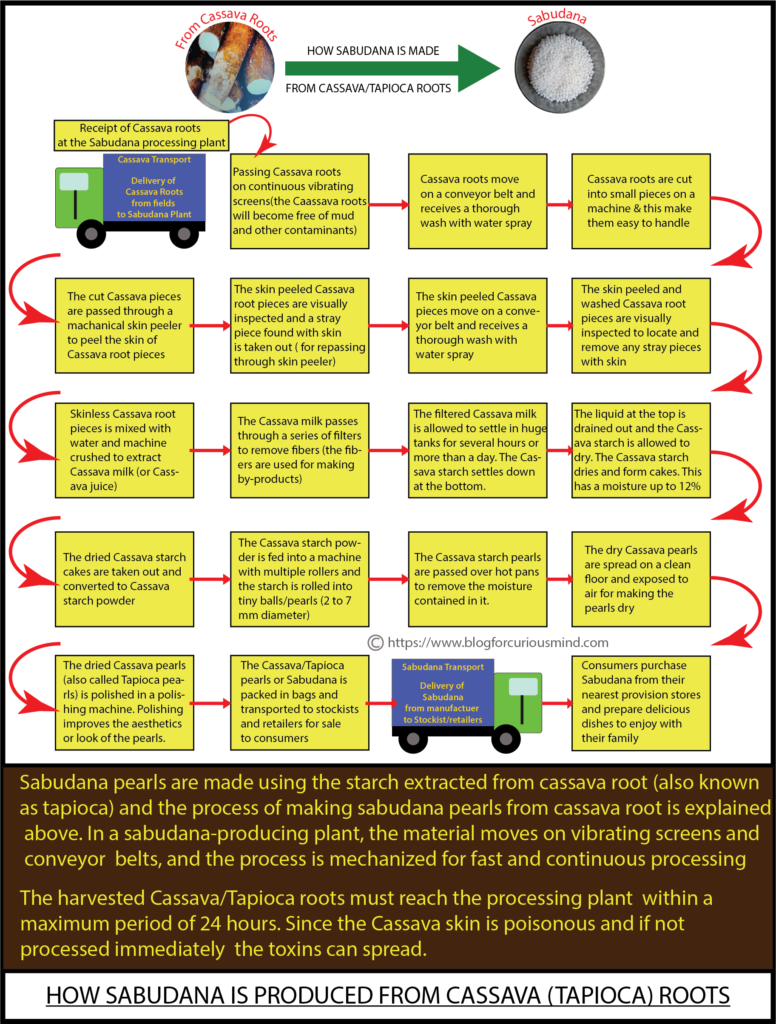
Step 2 Receipt of cassava roots at the processing plant
The Sabudana-producing plants are normally located within a short distance from the place of its cultivation. The harvested cassava roots are transported to the Sabudana-producing plants and they reach their destination well before 24 hours.
Step 3 cleaning the cassava roots
The cassava roots received in the truck are loaded onto the vibrating screens and as they move forward on the vibrating screen, the roots get rid of the mud adhered to them. This is a continuous process.
Step 4 washing the cassava roots
The cassava roots are now free of mud and move onto a conveyor belt for a thorough wash in water.
Step 4 Cutting the cassava roots into small pieces
The washed and clean cassava roots are fed into a continuous cutter. They are cut into small pieces for easy handling.
Step 5 skin peeling
The pieces of cassava root are passed through a continuous skin peeler to remove the skin.
The skinless pieces of cassava root move on the conveyor for a second wash in water.
Step 6 Visual inspection to ensure that the skin peeling is complete
The skinless pieces of cassava root moving over the conveyor belt are continuously monitored visually and cassava pieces that still have retained a patch of skin are manually removed and passed through the skin peeler once again
Step 7 washing
The skinless Cassava roots are washed thoroughly
One more visual inspection is done to locate and separate a stray piece that has a small patch of skin.
Step 8 Extraction of cassava juice or milk
The skinless pieces of cassava root are mixed with water and crushed to extract the juice/milk.
Step 9 Filtering of cassava milk
The white color cassava milk is passed through filters to filter out fibers
Step 10 cassava starch
The filtered cassava milk is allowed to settle in a large tank for a sufficiently long time. The heavy solid starch gets separated and settles at the bottom leaving the liquid at the top. The liquid is separated and the starch is allowed to dry and form cakes. The starch may have a moisture content of up to 12%. The whole process may take one or two days.
These cakes of starch are taken out and converted into powder. The starch powder is spread and exposed to sunlight.
Step 11 Converting cassava starch powder to small pearls
The cassava starch powder is passed through a machine containing rollers and it converts the powder into small balls. The diameter of the balls can be 2 to 7 mm and the machine can be set to produce the required size of starch balls.
These cassava pearls are passed over hot pans to take out the moisture.
Step 12 final touches
The completely dried cassava/tapioca pearls are passed through a polishing machine to give an aesthetic look to them. Now the Tapioca pearls are ready to be packed and sent to retailers for selling to the customers.
You may view the video
What is nylon Sabudana?
Like regular Sabudana, nylon Sabudana is also made using the starch obtained from cassava root. However, the process of making nylon Sabudana and its use is slightly different. It is called nylon Sabudana because it is shiny and semitransparent.
In the case of regular Sabudana, after the tapioca starch is rolled into pearls, the pearls are passed over hot pans to remove the moisture. The regular Sabudana should be soaked in water for 4 to 6 hours before it can become soft and ready for cooking. This is used for preparing kichadi, vada, kheer, papad, etc.
In the case of nylon Sabudana, after the tapioca starch is rolled into pearls, the pearls are steamed before drying. In other words, nylon Sabudana is precooked. It is oil-fried and used in fried items like mixtures (namkeen).
The nylon Sabudana will swell in size and become crispy after frying. It can be used directly, and soaking is not required.
Brief History of Sabudana in India
Tapioca in the form of 2 to 7-mm white pearls is very popular in India and is known by different names in different parts of India:
- Sabudana in Hindi, Marathi, Gujarati, Punjabi, etc.
- Sabbakki in Kannada
- Saggubiyyam in Telugu
- Javvarisi in Tamil
- Chavvari in Malayalam
The history of Sabudana says that the King of the Travancore Kingdom introduced tapioca or cassava in Kerala during the 1860s. The king’s botanist brother sourced the cassava crop from Brazil. The main purpose of this exercise was to find a solution to the extreme famine the kingdom was then going through.
The plan of the king was to consume the starch extracted from tapioca as a regular food during the difficult days of famine. Growing cassava roots do not need much attention. Its resistance against harsh climate conditions, like drought, makes it a lifesaving alternative food during difficult times. There will be more stories about how Sabudana came to India.
Tapioca is often called a poor man’s food and it was said to be the major food for the World War II refuges.
However, Sabudana pearls came much later. It was initially imported from Southeast Asia in the 1940s. The first unit for producing Sabudana in India was established in Salem, Tamil Nadu, in 1943.
Tapioca is a starch obtained from the spongy core of the cassava roots. It forms the major food in some parts of the world viz. New Guinea, Maluku Islands, etc. Tapioca starch and pearls were a vital part of Chinese cooking for hundreds of years. Tapioca starch is cooked and consumed in many forms like rolled balls, pancakes, etc.
Popular Sabudana dishes prepared in India
Sabudana is a favorite food in Maharashtra, Gujarat, part of Karnataka, and other places. Dishes made from Sabudana are popular staples during the ritual of fasting observed on many religious occasions including Navarathri.
The major advantage of Sabudana is it will not make your stomach heavy. But at the same time, it gives you the energy to pull on the fasting day. Sabudana is rich in carbohydrates, is gluten-free, and provides the essential energy to the human body for sustaining fasting.
Some of the popular Sabudana dishes are:
- Sabudana Kichadi
- Sabudana vada
- Sabudana kheer or payasam
- Sabudana papad
- Falooda is a popular dessert in big cities and many parts of India. It is made using vermicelli, milk, sweeteners, cooked Sabudana pearls, and other ingredients.
While Sabudana kichadi and vada are popular in Maharashtra and Gujarat, Sabudana payasam or kheer is popular in parts of south India including Karnataka. Sabudana pearls are good for making crunchy Sabudana papads. The new additions to the Sabudana dishes list are Sabudana Dosa and Sabudana Thalipeeth and they are yet to become popular.
The first step in cooking Sabudana for any dish is washing it thoroughly and soaking it in water for 4 to 6 hours or till the pearls become soft. Too much water should not be used for soaking it. A half-inch layer of water above the Sabudana will be sufficient. The Sabudana pearls absorb water and become bigger, nearly twice the original size, and soft. Insufficiently soaked Sabudana will remain hard after cooking or it may take longer to cook.
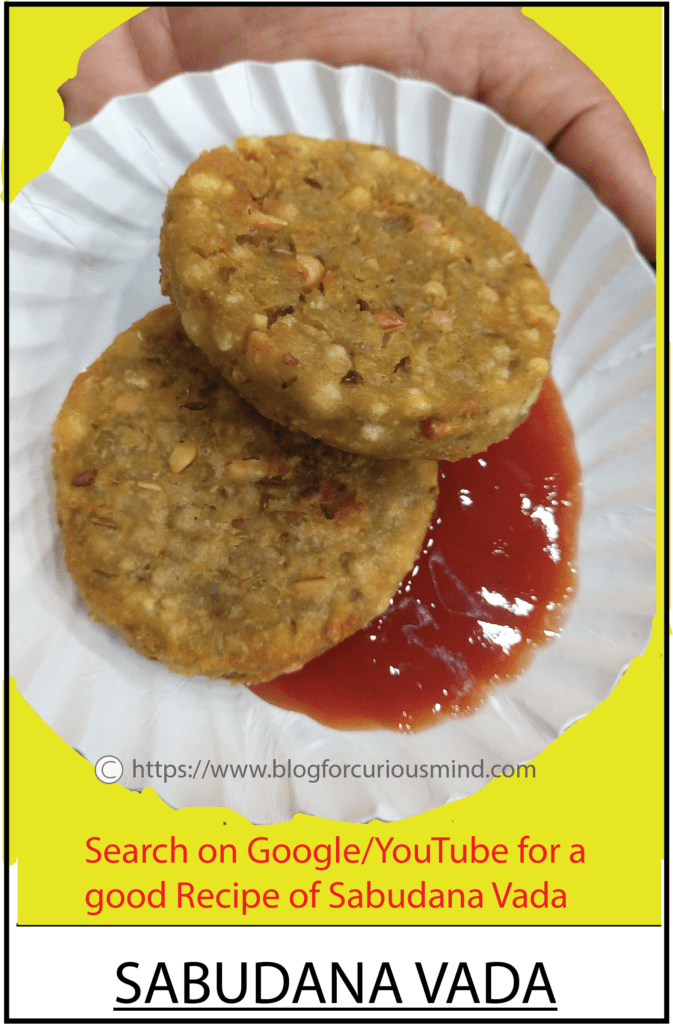
If proper care is not taken during soaking, the Sabudana pearls can become sticky or rubbery (chewy). Experienced cooks have many suggestions to avoid this. There are many videos on YouTube on how to prepare Sabudana dishes and you can view them before deciding on a cooking process.
The image below gives you the recipe for Sabudana Kheer.
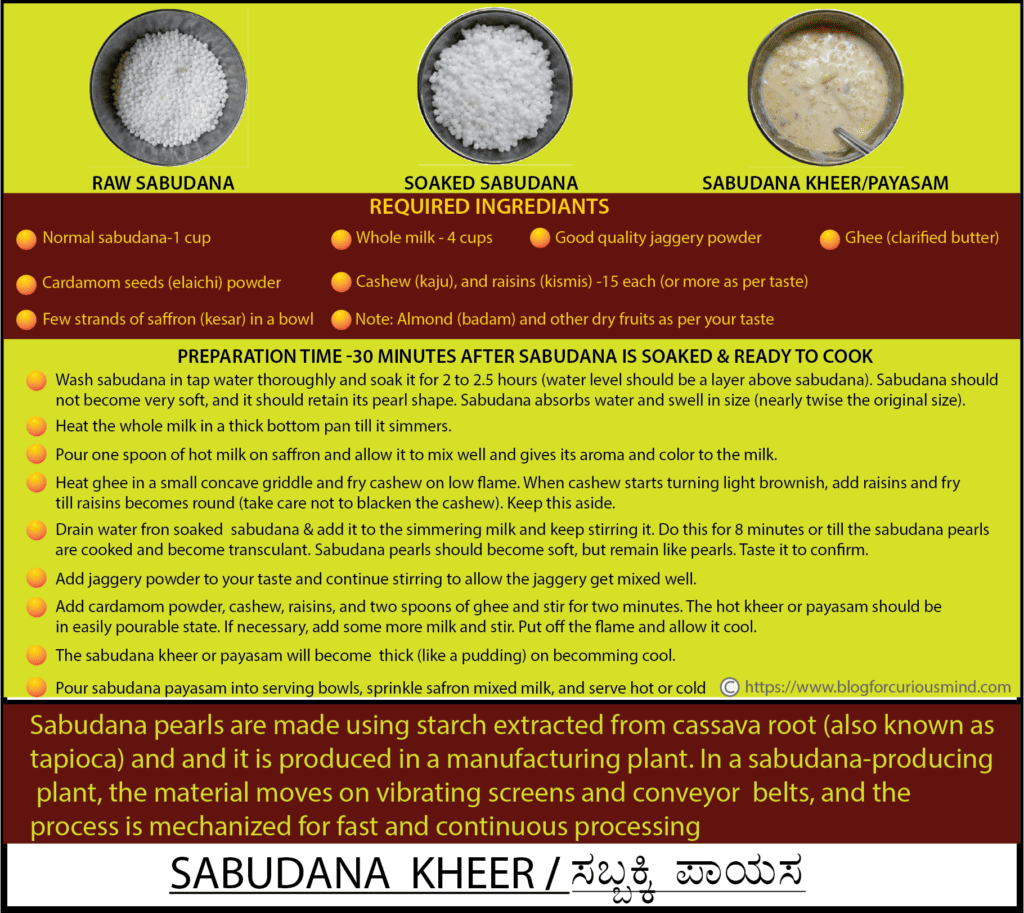
Food items prepared using tapioca pearls in other parts of the world
Tapioca or cassava starch in the form of pearls and flour is getting recognition as a gluten-free food and Paleolithic or Paleo diet. The Paleolithic diet was known to exist 10,000 years ago and it includes vegetables, fruits, fish, lean meats, eggs, nuts, etc. It is also known as the stone-age diet. Tapioca starch flour is gaining popularity as an alternative to refined wheat flour.
Some of the food items prepared from tapioca pearls in other parts of the world are briefly explained.
Bubble tea
Bubble tea is said to have originated in Taiwan and today it is a popular drink in many countries including the USA. A simple bubble tea has milk, sugar, tea, and tapioca pearls and is served cold. The tapioca pearls are made using tapioca starch with added flavors. The pearls are quite big in size.
Bubble tea has many names viz. boba tea, tapioca milk tea, bubble milk tea, boba, etc. A bubble tea can have added ingredients to make it attractive and tasty.
Cireng
Cireng is a popular street food in Jawa, Indonesia. It is prepared from sago starch or tapioca flour. The normal variety is prepared by adding garlic and various seasonings, but some preparations may have added meat or fish.
Sagu
Sagu is a Brazilian alcohol-based dessert and is prepared from tapioca pearls soaked in red wine. The tapioca pearls absorb the wine and turn red in color.
Banh Da Lon or tapioca cake
This is a Vietnamese delicacy. This dessert is made from the following ingredients viz. tapioca starch, rice flour, milk extracted from grated coconut, etc.
Taho
Taho is a Filipino dessert made from sago pearls, but tapioca pearls can also be used.
Ruam Mit
Ruam mit is a dessert made in Thailand and its ingredients include tapioca pearls, milk extracted from grated coconut, sugar, sweet potato, etc.
Salted cassava chips and strips
These are available as ready-to-eat packed snacks.
Health benefits of Sabudana
There can be arguments about the health or non-healthiness of consuming Sabudana in any form since the view of many experts is that Sabudana is high in carbohydrates and low in protein. This may be the reason why in Kerala, cooked tapioca starch (locally known as kappa) is eaten with fish to make up for the protein.
Sabudana, like rice, is rich in carbohydrates and gives energy to the body. But, Sabudana is not a diet for losing weight. If you are on a diet to lose weight, you should seek the opinion of a dietician and consume Sabudana in moderate quantities. Sabudana can be added to the list of ‘high-carb’ and ‘high-calorie’ foods.
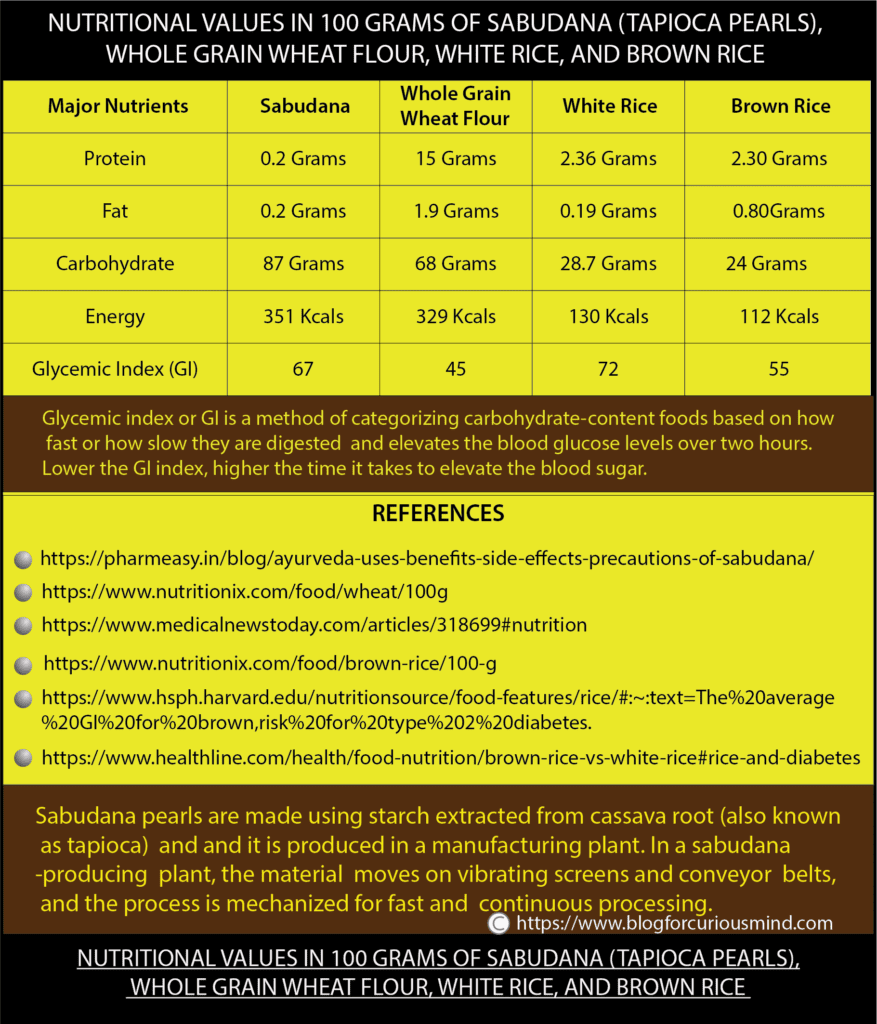
The health benefits of Sabudana include:
- The richness of the carbohydrates in Sabudana makes it a good source of energy. An ideal food for fasting days since the food consumption is normally less on fasting days.
- Sabudana is gluten-free. Gluten is a kind of protein found in grains like wheat. So, it is good for people who are sensitive to gluten.
- Sabudana contains dietary fiber and may help people with indigestion and constipation issues.
- Sabodana is rich in carbohydrates and low in fat. This makes it an ideal choice for gaining weight more healthily. Especially, Sabudana kichadi prepared with ground nuts and boiled potatoes gives good calories and energy. (consuming foods richer in fat increases the risk of heart-related issues).
- The Potassium content in Sabudana may help in controlling the blood pressure.
- The calcium content in Sabudana is good for your bones.
- Sabudana can be good for sick people due to its easily digestible properties. The carbohydrates in it provide fast energy.
- It has cooling properties for the human digestive system.
- It is said that Sabudana may have health benefits for diabetes patients and can help people affected by constipation.
Sabudana is considered moderately safe for diabetic people due to its low glycemic index. The glycemic index or GI is a method of categorizing carbohydrate-content foods based on how fast or how slow they are digested and elevates the blood glucose levels over two hours. The GI for Sabudana is 67, white rice 72, brown rice 55, and whole grain wheat flour 45. The lower the GI index higher the time it takes to elevate the blood sugar.
Caution: Each person reacts differently to a particular food including Sabudana. Hence, if you are inclined to replace part of your diet with Sabudana, please consult your dietician/nutritionist, or doctor, and seek their opinion before deciding.
Advantages of Sabudana
- The low moisture content (1 to 2%) of Sabudana means it has an increased storage life compared to normal grains, however, you need to store it in air-tight containers.
- A good food for people doing religious fasting.
- It can be used as a food thickener. The starch content of Sabudana makes it a good thickener for soups and similar foods.
- Popularly used in sweetened beverages viz. bubble teas, faloodas, etc.
- Sabudana starch is used for starching cotton clothes. Powder half a cup of Sabudana in the mixer and boil it in six cups of water to a lump-free starch liquid. Use this liquid to starch cotton clothes.
- The richness of Sabudana in carbohydrates makes it a good energy booster.
- Sabudana has a neutral flavor and can be added to soups and sauces as a thickener without disturbing its original taste.
- Adding Sabudana to bread dough can improve the texture of bread.
Disadvantages of Sabudana
The starch content in Sabudana is capable of fast energizing our body. However, the negligible protein content in Sabudana makes it a non-nutritional food. So if you intend to consume Sabudana regularly please take the advice of a doctor or nutritionist and follow his/her advice.
Consumption of Sabudana can have side effects for adults as well as children
Conclusion
Sabudana has many advantages. However, you must always purchase Sabudana from reputed and dependable sources and ensure it is of the best quality, and the manufacturer producing Sabudana from cassava roots has followed the correct process and hygienic conditions.
You may want to read the following articles.
How Poha is made from rice (paddy)
How rice is grown and harvested in India
Caution
The information included on this site is for educational purposes only. This is not intended to be a substitute for medical treatment by a healthcare professional. Because of unique individual needs, the reader should consult their physician to determine the appropriateness of the information for the reader’s situation. Please consult your doctor before adding Sabudana to your diet.

